- Messages
- 672
Choosing & Using A Straight Razor - pt 3
HONES
Call them what you will: whetstones, sharpening stones, waterstones or whatever - sooner or later your razor will have to come into contact with one or more of these. For our purposes we are only concerned with stones that use water as a lubricant, so oil-stones do not apply. They come in a large assortment of grades (aka grit sizes) from very coarse to ultra fine. The very coarse grades (eg 325 grit) are for taking off a lot of metal at a very rapid rate. A typical use would be to remove a chip or nick from the razors edge and set a new bevel (the bevel is kind of "v" shaped in cross section - the bevel planes on each side of the "v" must meet exactly, or no further amount of polishing/honing on successive hones will sharpen the blade).
Once the bevel is set, all we are doing is refining it. A rough rule of thumb is for the next hone to be approximately twice the grit rating of the last stone - the higher the grit size, the finer the hone. The series of stones used from setting the bevel to the final polishing of the blade is known as the "honing progression" - mine, for example, is 325, 600, 1000, 2000, 5000, 10,000 and 16,000. Once we have used a 4000, 5000 or 6000 grit stone, very little metal is removed from the bevels on advancing up the honing progression. If the bevel is not properly set by now, it is time to go back to a coarser stone. Imagine the "v" not coming to a point, but having a small flat area at it's peak before the next bevel coincides with it - all the finer stones will do is polish the steep face of each bevel, not remove the flat area at the top of the "v" so the blade will never be truly sharp and be unfit to shave with.
When to stop refining (or polishing) the bevel is a matter for personal choice. 8000 grit seems to be about the practical limit, while 10,000 will often give a superior shave. I stop on a 16,000 hone but many people go higher. The process of refinement need not stop with the honing stones - many people go from the final hone to a pasted paddle or strop and further refine the edge with compounds, powders and pastes.
USES
Damage Removal
To remove larger nicks, dings, fleabites - call them what you will, coarse hones must be used, for example between 325 grit and 1000 grit rating. For tiny areas of damage hones in the region of 1000 - 4000 grit will suffice. The coarser hones are also excellent at removing blade honing defects, like frowns (a narrower width in the middle of the blade) and smiles (a wider width in the middle of the blade). This is done by sawing the blade back-and forth (called "breadknifing" because the action is like cutting a slice of bread) until the profile is straight. Note that some smiles were intentional, particularly among older open razors. Such razors are often said to be more comfortable and forgiving to shave with, and some old barber manuals go into detail about setting a smile on a straight blade.
Essential Maintenance
Otherwise known as "touching up" - this is required whenever the blade feels a little dull after stropping or as a regular routine for keeping the edge in tip-top condition. All you need is a finishing hone, somewhere in the region of 10,000 grit or higher. Not may strokes are necessary - or desirable - about 5 laps should do it on a small barber-type hone (a lap is counted as a stroke one way plus a stroke the other way). On larger hones perhaps 2 or 3 laps is all that is required.
PRELIMINARIES
Using a Slurry
Some - though by no means all hones - can be made more versatile by the use of a slurry. Such hones are wetted and rubbed with a small piece of stone (it may be the same type of stone as the hone or a softer stone such as a nagura or artifiacial nagura) until a thin, milky slurry builds up. When used like this, the slurry constantly micro-abrades the surface of the hone so that fresh particles are exposed, making the honing go much faster. The downside is that it also makes the blade edge a little less refined. To get around this, towards the end of honing the slurry is constantly thinned with water, until only water remains. This will make the edge more finely polished and more refined. Some hones can even be used dry to get a bit more refinement from them. Don't expect to jump from say 4000 to 8000 grit on the same stone, though!
Lapping a Hone
Apart from diamond plates, all hones should be "lapped" (flattened) before use. Even those that are said to be ready to use straight from the vendor should be regarded with some suspicion and lapped as a matter of course. A diamond plate (see caveats under the relevant section) is quite handy to use, but not essetial. All you need is a flat surface such as a thick sheet of plate glass, granite or marble and a number of grades of wet'n'dry paper and plenty of water. Don't use normal sandpaper. Pour a small puddle of water onto the glass and lay the wet'n'dry on it, face up - the water will set up a suction and hold the paper in place. Soak the hone (if it is capable of being soaked) and draw a grid of lines with a pencil all over the surface to be lapped. Pour a puddle of water on the paper and lay the gridded face of the hone on it, then move it backwards and forwards as if sanding the surface. Every now and then remove the stone and look at the gridlines - areas where they have vanished indicate high areas on the hone, where the lines remain represent low areas on the hone. Keep flushing the paper with water and moving the hone over it until all the gridlines have vanished. To make doubly sure the hoen is flat, draw another grid on it and repeat. This routine is repeated on each ascending grit of wet'n'dry - you might want to start with a P100 grit and work up to P600 by way of P240 and P400, for example.
TYPES OF HONE
There a a number of different types of hone, man-made, ceramic, diamond plate and natural stone are, broadly speaking, the main types - although of course there are others. What to buy depends on personal choice, price, speed of operation and how much use you intend to give the hone, eg whether you hone for other people or just for yourself. Any recommendations I give are, of course, restricted to the hones I have used, are only my own personal opinions and other people may have conflicting views.
Man-Made/Synthetic/Artificial Hones
These can be had in all grit ratings, generally need soaking in water before use and are quite fast to very fast in operation. They can be one grit all the way though, or "combination" hones - two grits, one on either side.Makes include King, Ice Bear, Norton, Naniwa, etc. In my opinion the very coarse hones are not worth the bother - they need "lapping" or flattening (see later) very frequently - to frequently for my liking. The ones I have used for chip removal have required lapping during honing, otherwise the surface rapidly becoming concave had a deleterious effect on blade profile. They also drink water like it is going out of fashion - a 220 grit stone I used (Sun Tiger) was dry after 5 laps of the razor, even after having been soaked for 30 minutes. A bit much when a 100 laps or so are necessary to remove a small chip.
King brand - for my use, anything over 1000 is fine - they don't require lapping too often and they don't require as much water. I have used a number of 1000 grit stones and to my mind one of the best is the King. It is fast, relatively cheap, easy to obtain and doesn't need lapping too often. It is also available as a combination 1000/6000 stone which is very useful. The 6000 side is also a great performer. I personally rate these stones as better than the Norton 4000/8000 combination stones which are hard to come by at reasonable prices in the UK. These are used with a slurry, produced by rubbing a small slurry stone over the wet surface of the hone.

The Naniwa Super Hone series has very good feedback and is cheaper than the Nainwa Chosera series. I have used the whole range, from 1000 to 12,000 grit. All are very good - the 1000 is very fast (they are all quite fast in use) and both the 10,000 and 12,000 are ideal for final finishing hones. Each hone hardly needs more than a small spray of water and although soft they do not require lapping that often. They are very easy to lap, too, being soft - the only problem is "stiction" - a diamond plate is apt to stick quite doggedly to the hone unless the operation is carried out under water, under running water or a special perforated or grid-marked lapping plate is used. This holds true for a lot of other stones, too. The range is prone to dimensional changes, however, and should not be left in direct sunlight or next to open fires or radiators. No slurry or rubbing stone is required.
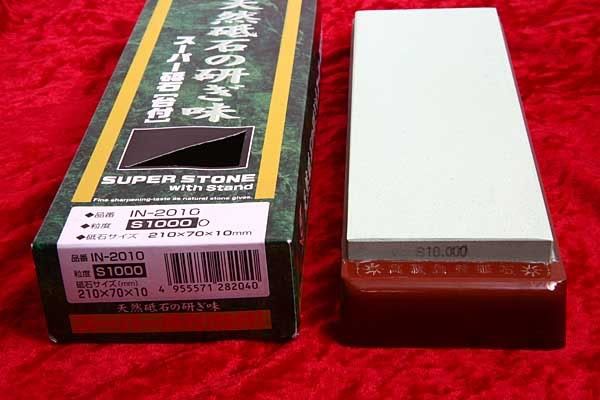
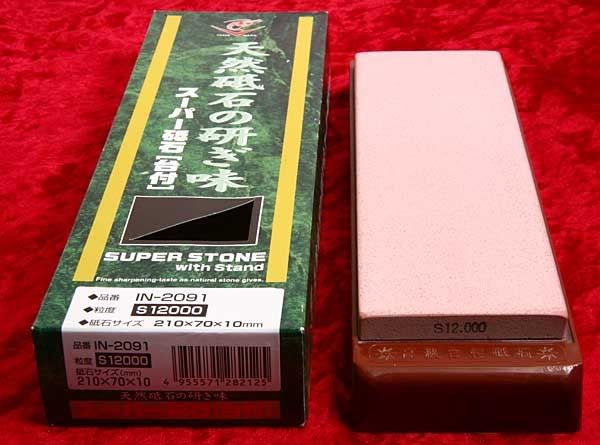
Each stone comes bonded to a plastic base with non-skid feet. If you don't operate a water pool system with stone holder, this is good news!
Ceramic Hones
Examples of these would be the small, old-style "barber" or razor hone, Spyderco and Shapton hones. The barber-style hones are great for travelling with as they are so small - most aren't more than six inches long - but this makes them a bit restrictive (at least for me) to use all the time. They are generally of a high-grit rating - say about 10,000 and above, unless you manage to find one of the rarer combination types with a coarse and a fine side. The vintage Swaty hones usually receive good reviews, particularly the type called "three line" (so known because it has three lines of writing on them). They are old now, and every one I have had has needed lapping. They are very hard usually, making lapping a bit of a chore, but not only does it level the surface it also helps to refine the grit to some extent, making some of them finer in operation.
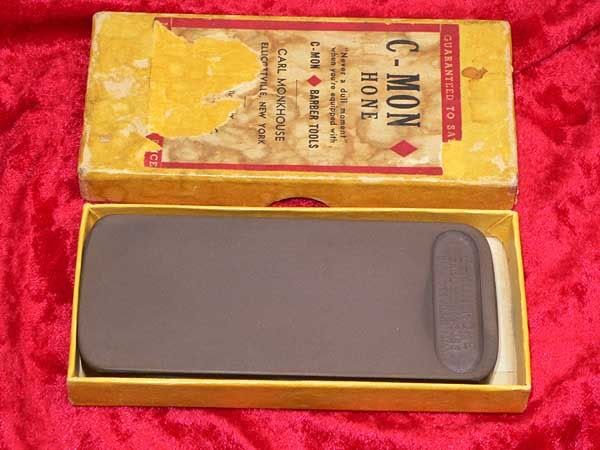

Spyderco: I have not used any of the Spyderco hones, chiefly due to what I have read about them being very hard and unforgiving, so I can't really comment on them other than they come in medium, fine and extra fine grades and tend to be on the small side. They were extremely hyped-up on some forums a while ago, like most new "finds" among hones tend to be (eg: Chinese 12k, Norton 4000/8000, Welsh Honing Slate, etc and currently Charnley Forest) - my advice is to let the hub-bub subside and the prices go down before deciding to buy.
Shapton: I use four Shapton Glass Stones (so-called because the backing is a flat plate of glass) - a 2000, 8000, 16,000 and a 30,000 grit. All are soft compared to most natural hone stones but do not require over-frequent lapping and they are very fast in use. However, "soft" needs some qualification: by soft I mean they do not feel like a glassy, hard stone in use, although in actuality they are quite hard - especially the 16,000 and 30,000 glass hones. This does not mean that they are a chore to lap - the hardness is nothing like that of a natural stone! The lower grits in this range are quite affordable, but the price rises quite steadily and by the time you get to the 30,000 hone you really have to justify the price. The 30,000 is about the same grit rating as chrome oxide powder, but to my mind better in use. However, I find that not all steels take to it - it over-refines some steels (particularly older Sheffield steels) and is detrimental to the edge. On modern hard steels it is fine. Some people recommend sticking with an all-Shapton line-up, saying that Shaptons don't get on with other hones. Mine have never expressed an opinion, though! No slurry or rubbing stone required. Shapton have another series of razor hones - Shapton Pro, much thicker and with no glass backing, but I have not tried these and so I can't comment.
Diamond Plate Hones
These are available in a number of grit sizes and from a number of manufacturers. I only have experience of the DMT range, so that's what will be discussed. These hones are basically a well-graded diamond dust bonded onto a solid steel plate. Obviously, they need no lapping. Ever. Some types, DMT included, are either coated all-over with diamond dust, or have little dots of diamond dust on them. Use the former for straight razors (they are also known as "continuous surface" hones). They need to be "seasoned" a bit before use on a razor - usually by drawing scrap steel (eg a screwdriver shaft) over the surface for some time. This clears the surface of any irregularities and build-ups. The range goes from Extra Coarse (325 grit) through Coarse, Fine, Extra Fine and Extra-Extra Fine. The latter is a particularly useful hone, designated DMT D8EE and being about 8000 grit. I use the extra-coarse and coarse for breadknifing, profiling and chip removal. They handle most materials with ease, though some materials are so hard (eg novaculite stones such as Arkansas) they actually reduce the efficiency of the diamond plate (and strip the surface of the finer diamond plates). A lot of people use diamond plates for lapping waterstones and the like, but care should be taken here - it is better to use the coarser plates and keep them liberally doused with water - or even use them under water, or the fine paste that builds up can spoil the surface - with the D8EE for example, people have reported areas of the plate losing patches of it's diamond covering.
Natural Hones/Waterstones
There are a large number of these available, some of questionable value to the open razor owner, some capable of superb results and others remarkably hyped-up - particularly on razor forums - beyond all reasonable measure. The British Isles sport a fair number of natural sharpening stones suitable for our uses. They range from low grit to finishing hones. A partial, though by no means comprehensive list follows.
Dalmore Yellow - quite a coarse hone from Scotland, approx. 2000 - 3000 grit. Usually quite slow in use, although - being a natural stone - it is subject to variations. I have had one reasonably fast one. A common complaint is that they are "sandy" in texture and small grains are apt to come loose and spoil the work.
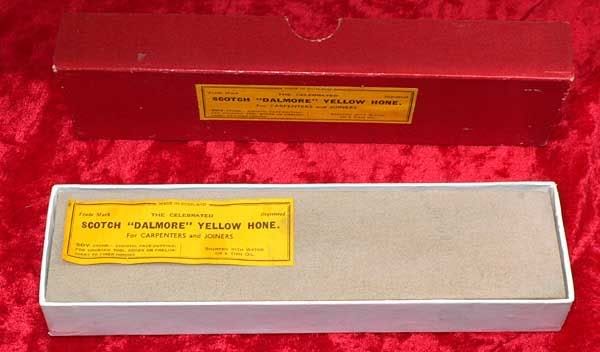
Dalmore Blue - from Scotland again, approx 4000 grit, perhaps peaking at 5000. Medium to slow speed, useful for refining a bevel but not really fast enough for setting one.
Tam O'Shanter - another from Scotland, approx 8000 grit, although some people rate them as low as 6000 grit - again, they are natural stones so there is no conformity to them. Lovely speckled pattern. Reasonably fast in use and considered by some as a finishing stone and for removing micro-nicks. If going on to a finer hone it is said to impart a smooth quality to the edge. It has another attractive quality too - it is one of the few hones that can be used effectively on razors that are prone to micro-chipping during honing. If used with a slurry (made by rubbing a slurry-stone over the surface) it cuts a lot faster.
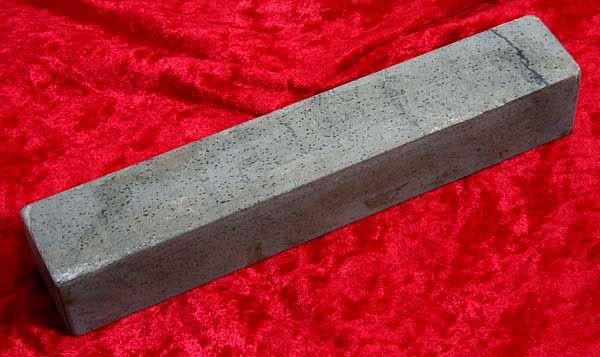
Below is another Tam O'Shanter variant:

An interesting point is that the Tam O'Shanter was sold in two varieties: one for cabinet makers, etc, and a "fine" version for razors. The distinction is made on the label and on the original box, so is not seen that often. The one fine version that I have been able to verify had a grit equivalence higher than my 8,000 grit stone. There is another variant which does not look like the other TOS stones - the white Tam O'Shanter. This one was sold for producing "very fine edges" and is finer again than the fine Tam O'Shanter mentioned above.
Below is a picture of a small white Tam O'Shanter followed by a picture of the label from another white Tam O'Shanter:
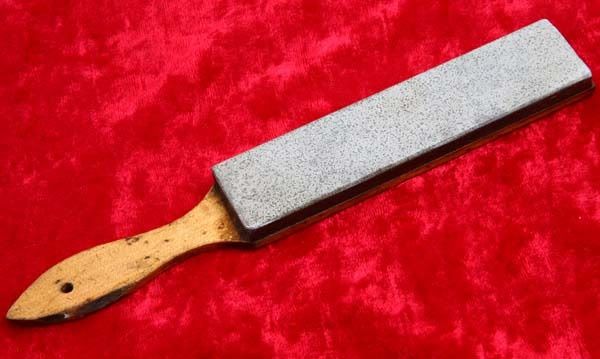

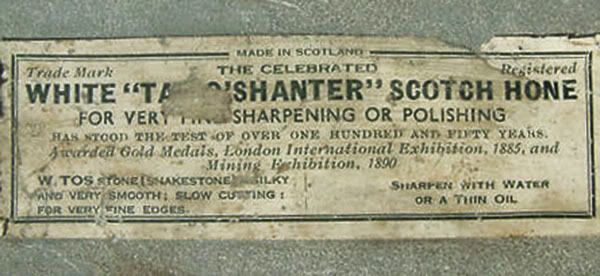
Water of Ayr - another offering from Scotland. The Tam O'Shanter was originally listed as "fine" and the Water of Ayr as "very fine." Historically, the Tam O'Shanter and Water of Ayr stones, although quite different, were lumped together and known as "Scottish hone" or "snake stone" so today there is still a little confusion so make sure of what you are buying - only the Tam is speckled. The Water of Ayr gives a very fine edge and is in the region of 9,000 - 11,000 grit size.
Belgian Blue Stone (BBW) - this stone occurs in the Ardennes and is a garnet-rich hone of around 4000 grit equivalent. Most of these hones give excellent polishing results, removing the lines left by coarser hones, but they are generally regarded as slow - too slow for bevel formation. The usual caveat applies - it is a natural stone, and different samples may display different characteristics. For instance, I have a BBW hand-selected by the mine owner - it is midway between a BBW and a yellow coticule in garnet size and cutting speed, and I would rate it somewhere above 5000 grit. Historically, the BBW was thought of as insignificant from a honing point of view, and was used as a backing for the yellow coticule because it was regarded as cheap and disposable (natural slate is used now). The BBW works with a slurry. It does not need to be soaked before use.
Belgian Yellow Coticule - these are remarkably versatile garnet-rich stones, found in the same place as the BBW. When soft, they can be used to cut metal quite fast with a creamy slurry, and do the work of 6000 - 8000 grit hones. Reducing the consistency of the slurry slows the cutting rate down, but makes the stone cut like a finer grit. Using just water provides the keenest edge (some say using it dry gives the keenest edge). Harder yellow coticules are not so good as cutters and are mainly intended to be final polishing hones. A conservative estimate of grit size would be around 10,000. The yellow coticule has long been prized as a honing stone - the Romans made much of them when they conquered the area. Devotees say they give a much smoother shave than other hones, due to the shape of the micro-garnets which smooth the edge. The older stones are said to be the best - certainly, one vintage coticule I owned was a superb finisher. Sometimes they are available as a combination stone, being bonded to a piece of BBW instead of slate (see above: this was a matter of convenience in the past, but a selling point now). The stone does not have to be soaked before use.
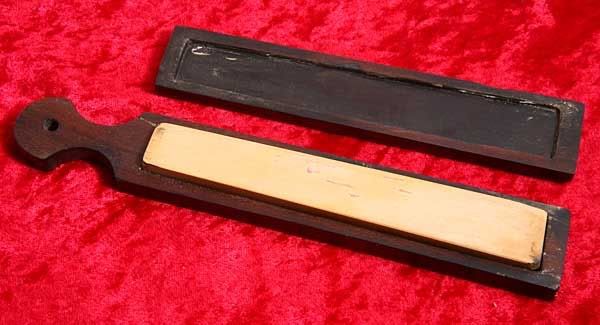
Thuringian Waterhones - there are a number of these currently available, of different grits. The german company Mueller (MST) mines them and grits available are 6000, 8000 and 10,000, although the last one is most commonly encountered. They are used with a rubbing stone to create a milky slurry, and can provide excellent results, although sometimes they have small, hard crystalline deposits in them. Much is made about these deposits in razor forums, but they can be plucked out with the tip of a knife and the small depression left will do no harm. The edges are quite commonly chamfered off at an oblique angle too - this is not seen as a flaw - it is done in-factory to remove any sharp brittle or broken edges. These hones are quite versatile and may be used with a heavy slurry to cut quite quickly. Using a heavy slurry gives the thuringian a cutting speed of a stone of slightly lower grit rating, but it will leave a slightly rounded edge. Working out the slurry by increasingly diluting it with plain water until just water is left will give the best edge - very sharp, but smooth at the same time, something like a coticule (but I must point out that my personal preference is for the thuringian).

The most famous waterhone from this region was the Escher water hone - there were a number of varieties, classified by colour, and grits were in the region of 11,000 - 12,000. The area has long since been mined-out, but Mueller did find some stock of old stone that had not been cut and began offering them as NOS (New Old Stock) Thuringian hones (note that Escher was really the trademark of a certain company). I have had one of these, a small stone, and it did give an extremely good edge. These stones do not need to be soaked before use. The real vintage Escher Thuringian Water Hones are sublime to use, especially in the larger sizes. They leave an incredible edge and a lot of users prefer them over the natural japanese stones (see below).
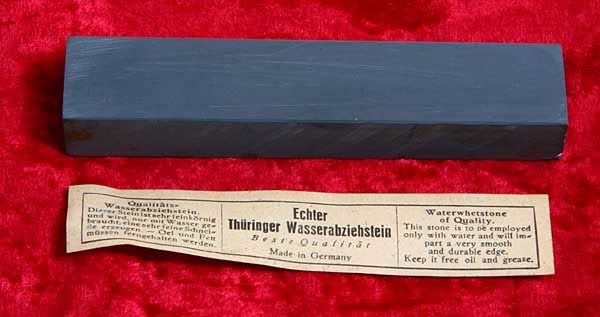
Above: a NOS thuringian. Note that "Echter" is german for 'real' or 'genuine' - not to be confused with "Escher" which was a name and trademark.
Welsh Honing Slate - although these are slates, they are mica-rich and it is this to which they owe their honing characteristics. The hone is still produced today but comes with a milled surface from the mine, which is no good for razors - it needs to be lapped. If done properly the surface can become quite "velvety" - you have to see it to understand what I mean. It is a fairly slow stone but increases in speed if used with a slurry. I would rate it at about 8,000- 10,000 grit - some specimens may be higher, others lower. It does not need to be soaked before use.

Chinese 12000 - a cheap stone and a great finishing stone from the Guangxi province of China. It is very hard, almost glass-like in use with little feedback. A lot of people use it as a finishing hone followed by a strop pasted with chrome oxide, but in my opinion if you do enough laps on the stone you don't need the pasted strop. It is very, very slow - frequently needing 100 laps to do its job, but these can be cut in half if used with a slurry. A 1000/6000 King, an MST thuringian and one of these make for a versatile and very cost-effective package. For some absurd reason it is often recommended that the Chinese 12000 is soaked before use - it even appears on one of the various types of packaging they come in. They are so hard and adamantine that I think you would have to soak one for months to get any water penetration - my advice is to save yourself the bother and just pour a puddle of water on it. The hardness makes them a bit of a chore to lap, too. I'm not convinced that they are really 12000 grit either - I have used a fair number, some performed a little worse than the Welsh Honing Slate, others about the same.

Arkansas Stones - there are a number of types of Arkansas stones available. They come from North America and are composed of virtually pure novaculite, a very hard, dense substance. The grades are soft, hard, surgical black and translucent. Don't go by colour - the colour comes from trace minerals and the same colours may be found in different types of Arkansas stone. Only two types need concern the open razor user - the surgical black and the translucent. Confusingly, although there is already a category recognised as "hard" these two are termed "true hard." The surgical type - so-called because it was much in demand for sharpening surgical implements - comes in black or blue-black colours while the translucent comes in many attractive shades: white, grey, pink, etc. Another confusing thing is that they cannot be classified by grit rating - rather, they are classified by specific gravity. The finest stones (surgical and translucent) would only rate a lowly 1200+ if rated by grit, but they polish like a very high-grit stone.
The only one I would bother with is the translucent - this is a superb finisher and gives an extremely fine edge. It is very slow in use and is used without slurry or a rubbing stone. It is so hard that it can ruin a diamond plate if you try to lap it with one!

Above: a translucent white arkansas stone.
Charnley Forest Hone - a very hard stone from Charnwood Forest in Leicestershire (the old parish was called Charnley). They give a particualrly fine edge. In Sheffield at the height of the razor-making area they were often used to "strike-off" the wire edge from a razor that had been freshly ground. They may be used with a light oil, or preferably water. Many of these vintage stones come in custom made hardwood boxes, which are saturated with oil, and the stone is often quite heavily dish. It is a bit of a pain to lap - anything more than a slight dishiong may take several hours to redress. There are basically two types of Charnley hone:



The above is the green/red figured variety, often with beautiful markings and swirls. These have to be examined quite closely, as most of the defects associated with this hone appear in the darker markings and include "pinny" inclusions which may damage the razors edge unless they are picked out. They range in finishing ability - old manuals say that this type is slightly inferior and coarser than the plain type, but the best examples of both are quite evenly matched.



Above is the plainer, darker variety - not so mossy green as the figured variety but usually an excellent finishing hone - the old manuals rate this type as best. Both types may be used with a small rubbing stone of the same material to speed-up the polishing process, which is quite slow. Finish with plain water, though, for the best edge.
Japanese Nakayama - a fine vintage hone from Japan. The Nakayama is the only type I have used - it is a very hard finishing hone, and quite versatile. A slurry may be built-up using a natural "nagura" stone and in use the slurry particle size breaks down finer and finer, so the razors edge becomes more refined as you continue to hone. That makes the hone quite versatile - one may go from a 4,000 or 8,000 grit hone straight to the japanese hone, and progress as if going through intermediate stones. Giving a grit size is problemataical with natural hones, and even more problematical here: every single stone has different qualities, but I would rate the one I used as anything from 12,000 to 16,000+. They require lapping only at extended intervals, being so hard. Often, the stone has lines and fracture marks in it - these appear to have been made long ago during the stones formation, and other material has seeped through the cracks and mineralised to form the solid stone. Each one has to be examined quite thoroughly for its ability to impart the best edge on a razor - some faults and inclusions bar them for use as razor hones.

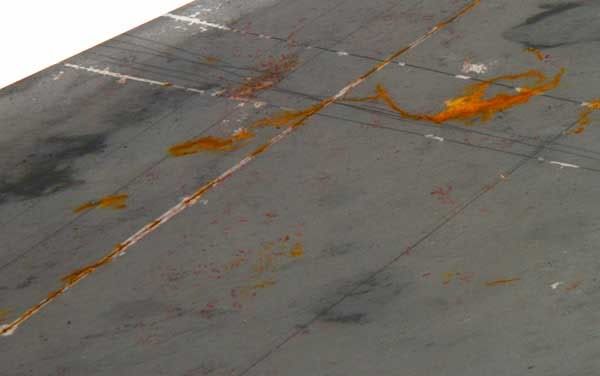
Below is a small natural "nagura" or rubbing stone, used for raising a slurry and for localised corrections of the japanese hone. It is a fairly soft stone, and is available in a number of grit sizes - this one is approx. 1000 grit. Unlike synthetic naguras, these break down quite quickly during honing, so the grit size becomes finer and finer:

That concludes my rather limited round-up of hones. Of course, there are many more honing stones such as Cutlers Green Hone from Snowdonia; Devonshire Oil Stone from Tavistock; Welsh Oil Stone from Llyn Idwall in Wales; Silkstone hone form Cambrock in England and so on, as well as the vast variety of natural Japanese Hones - very exotic and potentially very expensive! As stated above, the views expressed are my own and formed after years of using these products - no doubt others have different or conflicting views.
HONES
Call them what you will: whetstones, sharpening stones, waterstones or whatever - sooner or later your razor will have to come into contact with one or more of these. For our purposes we are only concerned with stones that use water as a lubricant, so oil-stones do not apply. They come in a large assortment of grades (aka grit sizes) from very coarse to ultra fine. The very coarse grades (eg 325 grit) are for taking off a lot of metal at a very rapid rate. A typical use would be to remove a chip or nick from the razors edge and set a new bevel (the bevel is kind of "v" shaped in cross section - the bevel planes on each side of the "v" must meet exactly, or no further amount of polishing/honing on successive hones will sharpen the blade).
Once the bevel is set, all we are doing is refining it. A rough rule of thumb is for the next hone to be approximately twice the grit rating of the last stone - the higher the grit size, the finer the hone. The series of stones used from setting the bevel to the final polishing of the blade is known as the "honing progression" - mine, for example, is 325, 600, 1000, 2000, 5000, 10,000 and 16,000. Once we have used a 4000, 5000 or 6000 grit stone, very little metal is removed from the bevels on advancing up the honing progression. If the bevel is not properly set by now, it is time to go back to a coarser stone. Imagine the "v" not coming to a point, but having a small flat area at it's peak before the next bevel coincides with it - all the finer stones will do is polish the steep face of each bevel, not remove the flat area at the top of the "v" so the blade will never be truly sharp and be unfit to shave with.
When to stop refining (or polishing) the bevel is a matter for personal choice. 8000 grit seems to be about the practical limit, while 10,000 will often give a superior shave. I stop on a 16,000 hone but many people go higher. The process of refinement need not stop with the honing stones - many people go from the final hone to a pasted paddle or strop and further refine the edge with compounds, powders and pastes.
USES
Damage Removal
To remove larger nicks, dings, fleabites - call them what you will, coarse hones must be used, for example between 325 grit and 1000 grit rating. For tiny areas of damage hones in the region of 1000 - 4000 grit will suffice. The coarser hones are also excellent at removing blade honing defects, like frowns (a narrower width in the middle of the blade) and smiles (a wider width in the middle of the blade). This is done by sawing the blade back-and forth (called "breadknifing" because the action is like cutting a slice of bread) until the profile is straight. Note that some smiles were intentional, particularly among older open razors. Such razors are often said to be more comfortable and forgiving to shave with, and some old barber manuals go into detail about setting a smile on a straight blade.
Essential Maintenance
Otherwise known as "touching up" - this is required whenever the blade feels a little dull after stropping or as a regular routine for keeping the edge in tip-top condition. All you need is a finishing hone, somewhere in the region of 10,000 grit or higher. Not may strokes are necessary - or desirable - about 5 laps should do it on a small barber-type hone (a lap is counted as a stroke one way plus a stroke the other way). On larger hones perhaps 2 or 3 laps is all that is required.
PRELIMINARIES
Using a Slurry
Some - though by no means all hones - can be made more versatile by the use of a slurry. Such hones are wetted and rubbed with a small piece of stone (it may be the same type of stone as the hone or a softer stone such as a nagura or artifiacial nagura) until a thin, milky slurry builds up. When used like this, the slurry constantly micro-abrades the surface of the hone so that fresh particles are exposed, making the honing go much faster. The downside is that it also makes the blade edge a little less refined. To get around this, towards the end of honing the slurry is constantly thinned with water, until only water remains. This will make the edge more finely polished and more refined. Some hones can even be used dry to get a bit more refinement from them. Don't expect to jump from say 4000 to 8000 grit on the same stone, though!
Lapping a Hone
Apart from diamond plates, all hones should be "lapped" (flattened) before use. Even those that are said to be ready to use straight from the vendor should be regarded with some suspicion and lapped as a matter of course. A diamond plate (see caveats under the relevant section) is quite handy to use, but not essetial. All you need is a flat surface such as a thick sheet of plate glass, granite or marble and a number of grades of wet'n'dry paper and plenty of water. Don't use normal sandpaper. Pour a small puddle of water onto the glass and lay the wet'n'dry on it, face up - the water will set up a suction and hold the paper in place. Soak the hone (if it is capable of being soaked) and draw a grid of lines with a pencil all over the surface to be lapped. Pour a puddle of water on the paper and lay the gridded face of the hone on it, then move it backwards and forwards as if sanding the surface. Every now and then remove the stone and look at the gridlines - areas where they have vanished indicate high areas on the hone, where the lines remain represent low areas on the hone. Keep flushing the paper with water and moving the hone over it until all the gridlines have vanished. To make doubly sure the hoen is flat, draw another grid on it and repeat. This routine is repeated on each ascending grit of wet'n'dry - you might want to start with a P100 grit and work up to P600 by way of P240 and P400, for example.
TYPES OF HONE
There a a number of different types of hone, man-made, ceramic, diamond plate and natural stone are, broadly speaking, the main types - although of course there are others. What to buy depends on personal choice, price, speed of operation and how much use you intend to give the hone, eg whether you hone for other people or just for yourself. Any recommendations I give are, of course, restricted to the hones I have used, are only my own personal opinions and other people may have conflicting views.
Man-Made/Synthetic/Artificial Hones
These can be had in all grit ratings, generally need soaking in water before use and are quite fast to very fast in operation. They can be one grit all the way though, or "combination" hones - two grits, one on either side.Makes include King, Ice Bear, Norton, Naniwa, etc. In my opinion the very coarse hones are not worth the bother - they need "lapping" or flattening (see later) very frequently - to frequently for my liking. The ones I have used for chip removal have required lapping during honing, otherwise the surface rapidly becoming concave had a deleterious effect on blade profile. They also drink water like it is going out of fashion - a 220 grit stone I used (Sun Tiger) was dry after 5 laps of the razor, even after having been soaked for 30 minutes. A bit much when a 100 laps or so are necessary to remove a small chip.
King brand - for my use, anything over 1000 is fine - they don't require lapping too often and they don't require as much water. I have used a number of 1000 grit stones and to my mind one of the best is the King. It is fast, relatively cheap, easy to obtain and doesn't need lapping too often. It is also available as a combination 1000/6000 stone which is very useful. The 6000 side is also a great performer. I personally rate these stones as better than the Norton 4000/8000 combination stones which are hard to come by at reasonable prices in the UK. These are used with a slurry, produced by rubbing a small slurry stone over the wet surface of the hone.

The Naniwa Super Hone series has very good feedback and is cheaper than the Nainwa Chosera series. I have used the whole range, from 1000 to 12,000 grit. All are very good - the 1000 is very fast (they are all quite fast in use) and both the 10,000 and 12,000 are ideal for final finishing hones. Each hone hardly needs more than a small spray of water and although soft they do not require lapping that often. They are very easy to lap, too, being soft - the only problem is "stiction" - a diamond plate is apt to stick quite doggedly to the hone unless the operation is carried out under water, under running water or a special perforated or grid-marked lapping plate is used. This holds true for a lot of other stones, too. The range is prone to dimensional changes, however, and should not be left in direct sunlight or next to open fires or radiators. No slurry or rubbing stone is required.


Each stone comes bonded to a plastic base with non-skid feet. If you don't operate a water pool system with stone holder, this is good news!
Ceramic Hones
Examples of these would be the small, old-style "barber" or razor hone, Spyderco and Shapton hones. The barber-style hones are great for travelling with as they are so small - most aren't more than six inches long - but this makes them a bit restrictive (at least for me) to use all the time. They are generally of a high-grit rating - say about 10,000 and above, unless you manage to find one of the rarer combination types with a coarse and a fine side. The vintage Swaty hones usually receive good reviews, particularly the type called "three line" (so known because it has three lines of writing on them). They are old now, and every one I have had has needed lapping. They are very hard usually, making lapping a bit of a chore, but not only does it level the surface it also helps to refine the grit to some extent, making some of them finer in operation.


Spyderco: I have not used any of the Spyderco hones, chiefly due to what I have read about them being very hard and unforgiving, so I can't really comment on them other than they come in medium, fine and extra fine grades and tend to be on the small side. They were extremely hyped-up on some forums a while ago, like most new "finds" among hones tend to be (eg: Chinese 12k, Norton 4000/8000, Welsh Honing Slate, etc and currently Charnley Forest) - my advice is to let the hub-bub subside and the prices go down before deciding to buy.
Shapton: I use four Shapton Glass Stones (so-called because the backing is a flat plate of glass) - a 2000, 8000, 16,000 and a 30,000 grit. All are soft compared to most natural hone stones but do not require over-frequent lapping and they are very fast in use. However, "soft" needs some qualification: by soft I mean they do not feel like a glassy, hard stone in use, although in actuality they are quite hard - especially the 16,000 and 30,000 glass hones. This does not mean that they are a chore to lap - the hardness is nothing like that of a natural stone! The lower grits in this range are quite affordable, but the price rises quite steadily and by the time you get to the 30,000 hone you really have to justify the price. The 30,000 is about the same grit rating as chrome oxide powder, but to my mind better in use. However, I find that not all steels take to it - it over-refines some steels (particularly older Sheffield steels) and is detrimental to the edge. On modern hard steels it is fine. Some people recommend sticking with an all-Shapton line-up, saying that Shaptons don't get on with other hones. Mine have never expressed an opinion, though! No slurry or rubbing stone required. Shapton have another series of razor hones - Shapton Pro, much thicker and with no glass backing, but I have not tried these and so I can't comment.
Diamond Plate Hones
These are available in a number of grit sizes and from a number of manufacturers. I only have experience of the DMT range, so that's what will be discussed. These hones are basically a well-graded diamond dust bonded onto a solid steel plate. Obviously, they need no lapping. Ever. Some types, DMT included, are either coated all-over with diamond dust, or have little dots of diamond dust on them. Use the former for straight razors (they are also known as "continuous surface" hones). They need to be "seasoned" a bit before use on a razor - usually by drawing scrap steel (eg a screwdriver shaft) over the surface for some time. This clears the surface of any irregularities and build-ups. The range goes from Extra Coarse (325 grit) through Coarse, Fine, Extra Fine and Extra-Extra Fine. The latter is a particularly useful hone, designated DMT D8EE and being about 8000 grit. I use the extra-coarse and coarse for breadknifing, profiling and chip removal. They handle most materials with ease, though some materials are so hard (eg novaculite stones such as Arkansas) they actually reduce the efficiency of the diamond plate (and strip the surface of the finer diamond plates). A lot of people use diamond plates for lapping waterstones and the like, but care should be taken here - it is better to use the coarser plates and keep them liberally doused with water - or even use them under water, or the fine paste that builds up can spoil the surface - with the D8EE for example, people have reported areas of the plate losing patches of it's diamond covering.
Natural Hones/Waterstones
There are a large number of these available, some of questionable value to the open razor owner, some capable of superb results and others remarkably hyped-up - particularly on razor forums - beyond all reasonable measure. The British Isles sport a fair number of natural sharpening stones suitable for our uses. They range from low grit to finishing hones. A partial, though by no means comprehensive list follows.
Dalmore Yellow - quite a coarse hone from Scotland, approx. 2000 - 3000 grit. Usually quite slow in use, although - being a natural stone - it is subject to variations. I have had one reasonably fast one. A common complaint is that they are "sandy" in texture and small grains are apt to come loose and spoil the work.

Dalmore Blue - from Scotland again, approx 4000 grit, perhaps peaking at 5000. Medium to slow speed, useful for refining a bevel but not really fast enough for setting one.
Tam O'Shanter - another from Scotland, approx 8000 grit, although some people rate them as low as 6000 grit - again, they are natural stones so there is no conformity to them. Lovely speckled pattern. Reasonably fast in use and considered by some as a finishing stone and for removing micro-nicks. If going on to a finer hone it is said to impart a smooth quality to the edge. It has another attractive quality too - it is one of the few hones that can be used effectively on razors that are prone to micro-chipping during honing. If used with a slurry (made by rubbing a slurry-stone over the surface) it cuts a lot faster.

Below is another Tam O'Shanter variant:

An interesting point is that the Tam O'Shanter was sold in two varieties: one for cabinet makers, etc, and a "fine" version for razors. The distinction is made on the label and on the original box, so is not seen that often. The one fine version that I have been able to verify had a grit equivalence higher than my 8,000 grit stone. There is another variant which does not look like the other TOS stones - the white Tam O'Shanter. This one was sold for producing "very fine edges" and is finer again than the fine Tam O'Shanter mentioned above.
Below is a picture of a small white Tam O'Shanter followed by a picture of the label from another white Tam O'Shanter:



Water of Ayr - another offering from Scotland. The Tam O'Shanter was originally listed as "fine" and the Water of Ayr as "very fine." Historically, the Tam O'Shanter and Water of Ayr stones, although quite different, were lumped together and known as "Scottish hone" or "snake stone" so today there is still a little confusion so make sure of what you are buying - only the Tam is speckled. The Water of Ayr gives a very fine edge and is in the region of 9,000 - 11,000 grit size.
Belgian Blue Stone (BBW) - this stone occurs in the Ardennes and is a garnet-rich hone of around 4000 grit equivalent. Most of these hones give excellent polishing results, removing the lines left by coarser hones, but they are generally regarded as slow - too slow for bevel formation. The usual caveat applies - it is a natural stone, and different samples may display different characteristics. For instance, I have a BBW hand-selected by the mine owner - it is midway between a BBW and a yellow coticule in garnet size and cutting speed, and I would rate it somewhere above 5000 grit. Historically, the BBW was thought of as insignificant from a honing point of view, and was used as a backing for the yellow coticule because it was regarded as cheap and disposable (natural slate is used now). The BBW works with a slurry. It does not need to be soaked before use.
Belgian Yellow Coticule - these are remarkably versatile garnet-rich stones, found in the same place as the BBW. When soft, they can be used to cut metal quite fast with a creamy slurry, and do the work of 6000 - 8000 grit hones. Reducing the consistency of the slurry slows the cutting rate down, but makes the stone cut like a finer grit. Using just water provides the keenest edge (some say using it dry gives the keenest edge). Harder yellow coticules are not so good as cutters and are mainly intended to be final polishing hones. A conservative estimate of grit size would be around 10,000. The yellow coticule has long been prized as a honing stone - the Romans made much of them when they conquered the area. Devotees say they give a much smoother shave than other hones, due to the shape of the micro-garnets which smooth the edge. The older stones are said to be the best - certainly, one vintage coticule I owned was a superb finisher. Sometimes they are available as a combination stone, being bonded to a piece of BBW instead of slate (see above: this was a matter of convenience in the past, but a selling point now). The stone does not have to be soaked before use.

Thuringian Waterhones - there are a number of these currently available, of different grits. The german company Mueller (MST) mines them and grits available are 6000, 8000 and 10,000, although the last one is most commonly encountered. They are used with a rubbing stone to create a milky slurry, and can provide excellent results, although sometimes they have small, hard crystalline deposits in them. Much is made about these deposits in razor forums, but they can be plucked out with the tip of a knife and the small depression left will do no harm. The edges are quite commonly chamfered off at an oblique angle too - this is not seen as a flaw - it is done in-factory to remove any sharp brittle or broken edges. These hones are quite versatile and may be used with a heavy slurry to cut quite quickly. Using a heavy slurry gives the thuringian a cutting speed of a stone of slightly lower grit rating, but it will leave a slightly rounded edge. Working out the slurry by increasingly diluting it with plain water until just water is left will give the best edge - very sharp, but smooth at the same time, something like a coticule (but I must point out that my personal preference is for the thuringian).

The most famous waterhone from this region was the Escher water hone - there were a number of varieties, classified by colour, and grits were in the region of 11,000 - 12,000. The area has long since been mined-out, but Mueller did find some stock of old stone that had not been cut and began offering them as NOS (New Old Stock) Thuringian hones (note that Escher was really the trademark of a certain company). I have had one of these, a small stone, and it did give an extremely good edge. These stones do not need to be soaked before use. The real vintage Escher Thuringian Water Hones are sublime to use, especially in the larger sizes. They leave an incredible edge and a lot of users prefer them over the natural japanese stones (see below).

Above: a NOS thuringian. Note that "Echter" is german for 'real' or 'genuine' - not to be confused with "Escher" which was a name and trademark.
Welsh Honing Slate - although these are slates, they are mica-rich and it is this to which they owe their honing characteristics. The hone is still produced today but comes with a milled surface from the mine, which is no good for razors - it needs to be lapped. If done properly the surface can become quite "velvety" - you have to see it to understand what I mean. It is a fairly slow stone but increases in speed if used with a slurry. I would rate it at about 8,000- 10,000 grit - some specimens may be higher, others lower. It does not need to be soaked before use.

Chinese 12000 - a cheap stone and a great finishing stone from the Guangxi province of China. It is very hard, almost glass-like in use with little feedback. A lot of people use it as a finishing hone followed by a strop pasted with chrome oxide, but in my opinion if you do enough laps on the stone you don't need the pasted strop. It is very, very slow - frequently needing 100 laps to do its job, but these can be cut in half if used with a slurry. A 1000/6000 King, an MST thuringian and one of these make for a versatile and very cost-effective package. For some absurd reason it is often recommended that the Chinese 12000 is soaked before use - it even appears on one of the various types of packaging they come in. They are so hard and adamantine that I think you would have to soak one for months to get any water penetration - my advice is to save yourself the bother and just pour a puddle of water on it. The hardness makes them a bit of a chore to lap, too. I'm not convinced that they are really 12000 grit either - I have used a fair number, some performed a little worse than the Welsh Honing Slate, others about the same.

Arkansas Stones - there are a number of types of Arkansas stones available. They come from North America and are composed of virtually pure novaculite, a very hard, dense substance. The grades are soft, hard, surgical black and translucent. Don't go by colour - the colour comes from trace minerals and the same colours may be found in different types of Arkansas stone. Only two types need concern the open razor user - the surgical black and the translucent. Confusingly, although there is already a category recognised as "hard" these two are termed "true hard." The surgical type - so-called because it was much in demand for sharpening surgical implements - comes in black or blue-black colours while the translucent comes in many attractive shades: white, grey, pink, etc. Another confusing thing is that they cannot be classified by grit rating - rather, they are classified by specific gravity. The finest stones (surgical and translucent) would only rate a lowly 1200+ if rated by grit, but they polish like a very high-grit stone.
The only one I would bother with is the translucent - this is a superb finisher and gives an extremely fine edge. It is very slow in use and is used without slurry or a rubbing stone. It is so hard that it can ruin a diamond plate if you try to lap it with one!

Above: a translucent white arkansas stone.
Charnley Forest Hone - a very hard stone from Charnwood Forest in Leicestershire (the old parish was called Charnley). They give a particualrly fine edge. In Sheffield at the height of the razor-making area they were often used to "strike-off" the wire edge from a razor that had been freshly ground. They may be used with a light oil, or preferably water. Many of these vintage stones come in custom made hardwood boxes, which are saturated with oil, and the stone is often quite heavily dish. It is a bit of a pain to lap - anything more than a slight dishiong may take several hours to redress. There are basically two types of Charnley hone:



The above is the green/red figured variety, often with beautiful markings and swirls. These have to be examined quite closely, as most of the defects associated with this hone appear in the darker markings and include "pinny" inclusions which may damage the razors edge unless they are picked out. They range in finishing ability - old manuals say that this type is slightly inferior and coarser than the plain type, but the best examples of both are quite evenly matched.



Above is the plainer, darker variety - not so mossy green as the figured variety but usually an excellent finishing hone - the old manuals rate this type as best. Both types may be used with a small rubbing stone of the same material to speed-up the polishing process, which is quite slow. Finish with plain water, though, for the best edge.
Japanese Nakayama - a fine vintage hone from Japan. The Nakayama is the only type I have used - it is a very hard finishing hone, and quite versatile. A slurry may be built-up using a natural "nagura" stone and in use the slurry particle size breaks down finer and finer, so the razors edge becomes more refined as you continue to hone. That makes the hone quite versatile - one may go from a 4,000 or 8,000 grit hone straight to the japanese hone, and progress as if going through intermediate stones. Giving a grit size is problemataical with natural hones, and even more problematical here: every single stone has different qualities, but I would rate the one I used as anything from 12,000 to 16,000+. They require lapping only at extended intervals, being so hard. Often, the stone has lines and fracture marks in it - these appear to have been made long ago during the stones formation, and other material has seeped through the cracks and mineralised to form the solid stone. Each one has to be examined quite thoroughly for its ability to impart the best edge on a razor - some faults and inclusions bar them for use as razor hones.


Below is a small natural "nagura" or rubbing stone, used for raising a slurry and for localised corrections of the japanese hone. It is a fairly soft stone, and is available in a number of grit sizes - this one is approx. 1000 grit. Unlike synthetic naguras, these break down quite quickly during honing, so the grit size becomes finer and finer:

That concludes my rather limited round-up of hones. Of course, there are many more honing stones such as Cutlers Green Hone from Snowdonia; Devonshire Oil Stone from Tavistock; Welsh Oil Stone from Llyn Idwall in Wales; Silkstone hone form Cambrock in England and so on, as well as the vast variety of natural Japanese Hones - very exotic and potentially very expensive! As stated above, the views expressed are my own and formed after years of using these products - no doubt others have different or conflicting views.
